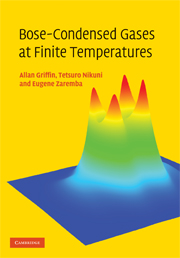Book contents
- Frontmatter
- Contents
- Preface
- 1 Overview and introduction
- 2 Condensate dynamics at T = 0
- 3 Coupled equations for the condensate and thermal cloud
- 4 Green's functions and self-energy approximations
- 5 The Beliaev and the time-dependent HFB approximations
- 6 Kadanoff–Baym derivation of the ZNG equations
- 7 Kinetic equation for Bogoliubov thermal excitations
- 8 Static thermal cloud approximation
- 9 Vortices and vortex lattices at finite temperatures
- 10 Dynamics at finite temperatures using the moment method
- 11 Numerical simulation of the ZNG equations
- 12 Simulation of collective modes at finite temperature
- 13 Landau damping in trapped Bose-condensed gases
- 14 Landau's theory of superfluidity
- 15 Two-fluid hydrodynamics in a dilute Bose gas
- 16 Variational formulation of the Landau two-fluid equations
- 17 The Landau–Khalatnikov two-fluid equations
- 18 Transport coefficients and relaxation times
- 19 General theory of damping of hydrodynamic modes
- Appendix A Monte Carlo calculation of collision rates
- Appendix B Evaluation of transport coefficients: technical details
- Appendix C Frequency-dependent transport coefficients
- Appendix D Derivation of hydrodynamic damping formula
- References
- Index
13 - Landau damping in trapped Bose-condensed gases
Published online by Cambridge University Press: 06 October 2009
- Frontmatter
- Contents
- Preface
- 1 Overview and introduction
- 2 Condensate dynamics at T = 0
- 3 Coupled equations for the condensate and thermal cloud
- 4 Green's functions and self-energy approximations
- 5 The Beliaev and the time-dependent HFB approximations
- 6 Kadanoff–Baym derivation of the ZNG equations
- 7 Kinetic equation for Bogoliubov thermal excitations
- 8 Static thermal cloud approximation
- 9 Vortices and vortex lattices at finite temperatures
- 10 Dynamics at finite temperatures using the moment method
- 11 Numerical simulation of the ZNG equations
- 12 Simulation of collective modes at finite temperature
- 13 Landau damping in trapped Bose-condensed gases
- 14 Landau's theory of superfluidity
- 15 Two-fluid hydrodynamics in a dilute Bose gas
- 16 Variational formulation of the Landau two-fluid equations
- 17 The Landau–Khalatnikov two-fluid equations
- 18 Transport coefficients and relaxation times
- 19 General theory of damping of hydrodynamic modes
- Appendix A Monte Carlo calculation of collision rates
- Appendix B Evaluation of transport coefficients: technical details
- Appendix C Frequency-dependent transport coefficients
- Appendix D Derivation of hydrodynamic damping formula
- References
- Index
Summary
With very few exceptions (such as the centre-of-mass dipole mode), collective oscillations in trapped superfluid Bose gases are damped. In the “collisionless” region the damping is second order in the interaction strength. There are three possible components. One is Beliaev damping, which is due to the decay of a single excitation into two excitations; this can occur even at T = 0. In addition, there is Landau damping, which is due to a collective mode scattering from thermally excited excitations. This process only occurs at finite temperatures but quickly becomes the dominant damping mechanism as the temperature increases. Both Landau and Beliaev damping arise naturally from the imaginary part of the Beliaev second-order self-energies, as given in (5.40) in the case of a uniform Bose gas. Finally there is the damping that arises from the C22 and C12 collision processes; this is discussed in Chapters 8, 12 and 19.
In Chapter 12 we calculated the damping of various condensate modes at finite temperatures using direct numerical simulations of the ZNG equations. These numerical results were generally in very good agreement with the available experimental data. From a theoretical perspective, one advantage of the simulations is that the Landau damping contribution can be isolated simply by setting the C12 and C22 collision terms to zero.
After providing an introduction to Landau damping in uniform Bose gases in Section 13.1, we present in Section 13.2 a detailed discussion of Landau damping based on a general formula in terms of Bogoliubov–Popov excitations. This discussion makes it clear that the Landau damping of condensate oscillations arises from the interaction with a thermal cloud of excitations.
- Type
- Chapter
- Information
- Bose-Condensed Gases at Finite Temperatures , pp. 292 - 308Publisher: Cambridge University PressPrint publication year: 2009



